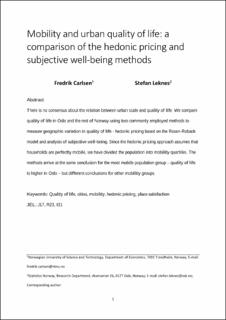| dc.contributor.author | Carlsen, Fredrik | |
| dc.contributor.author | Leknes, Stefan | |
| dc.date.accessioned | 2022-11-23T13:03:42Z | |
| dc.date.available | 2022-11-23T13:03:42Z | |
| dc.date.created | 2020-08-25T09:58:27Z | |
| dc.date.issued | 2020 | |
| dc.identifier.citation | Regional studies. 2020, . | en_US |
| dc.identifier.issn | 0034-3404 | |
| dc.identifier.uri | https://hdl.handle.net/11250/3033664 | |
| dc.description.abstract | There is no consensus about the relation between urban scale and quality of life. Quality of life in Oslo and the rest of Norway is compared using two commonly employed methods to measure geographical variation in quality of life: hedonic pricing based on the Rosen–Roback model and analysis of subjective well-being. Since the hedonic pricing approach assumes that households are perfectly mobile, the population is divided into mobility quartiles. The methods arrive at the same conclusion for the most mobile population group – quality of life is higher in Oslo – but different conclusions are reached for other mobility groups. | en_US |
| dc.language.iso | eng | en_US |
| dc.publisher | Taylor and Francis Group | en_US |
| dc.title | Mobility and urban quality of life: a comparison of the hedonic pricing and subjective well-being methods | en_US |
| dc.type | Journal article | en_US |
| dc.type | Peer reviewed | en_US |
| dc.description.version | acceptedVersion | en_US |
| dc.source.pagenumber | 12 | en_US |
| dc.source.journal | Regional studies | en_US |
| dc.identifier.doi | 10.1080/00343404.2020.1800624 | |
| dc.identifier.cristin | 1824936 | |
| dc.relation.project | Norges forskningsråd: 255509 | en_US |
| cristin.ispublished | true | |
| cristin.fulltext | postprint | |
| cristin.qualitycode | 1 | |
